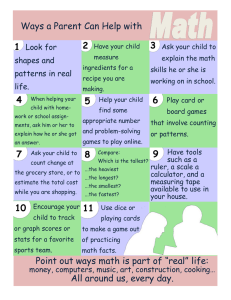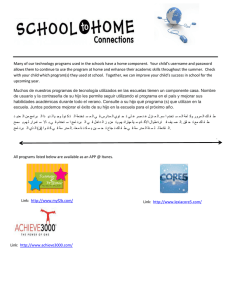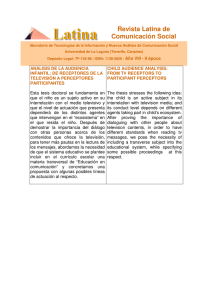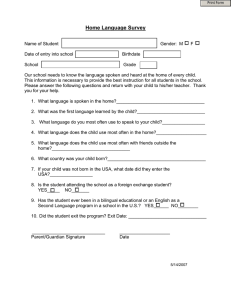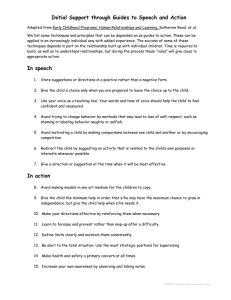Helping Your Child Learn Two Languages
Anuncio
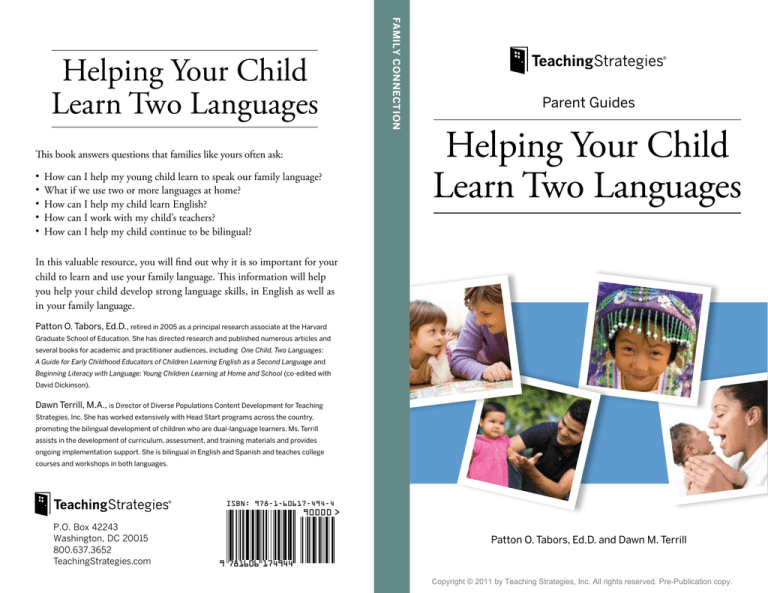
This book answers questions that families like yours often ask: • How can I help my young child learn to speak our family language? • What if we use two or more languages at home? • How can I help my child learn English? • How can I work with my child’s teachers? • How can I help my child continue to be bilingual? FAMILY CONNECTION Helping Your Child Learn Two Languages Parent Guides Helping Your Child Learn Two Languages In this valuable resource, you will find out why it is so important for your child to learn and use your family language. This information will help you help your child develop strong language skills, in English as well as in your family language. Patton O. Tabors, Ed.D., retired in 2005 as a principal research associate at the Harvard Graduate School of Education. She has directed research and published numerous articles and several books for academic and practitioner audiences, including One Child, Two Languages: A Guide for Early Childhood Educators of Children Learning English as a Second Language and Beginning Literacy with Language: Young Children Learning at Home and School (co-edited with David Dickinson). Dawn Terrill, M.A., is Director of Diverse Populations Content Development for Teaching Strategies, Inc. She has worked extensively with Head Start programs across the country, promoting the bilingual development of children who are dual-language learners. Ms. Terrill assists in the development of curriculum, assessment, and training materials and provides ongoing implementation support. She is bilingual in English and Spanish and teaches college courses and workshops in both languages. ISBN: 978-1-60617-494-4 90000 > P.O. Box 42243 Washington, DC 20015 800.637.3652 TeachingStrategies.com Patton O. Tabors, Ed.D. and Dawn M. Terrill 9 781606 174944 Copyright © 2011 by Teaching Strategies, Inc. All rights reserved. Pre-Publication copy. Este libro contesta las preguntas que familias como la suya hacen con frecuencia: • ¿Cómo puedo ayudar a mi niño pequeño a aprender a hablar nuestro idioma familiar? • ¿Y si usamos dos o más idiomas en casa? • ¿Cómo puedo ayudar a mi niño a aprender inglés? • ¿Cómo puedo cooperar con los maestros de mi niño? conexión con la familia Pasos para ayudar a su niño a aprender dos idiomas Una guía para los padres Pasos para ayudar a su niño a aprender dos idiomas Con este valioso recurso, verá por qué es tan importante que su niño aprenda y use su idioma familiar. Con esta información, usted sabrá cómo ayudar al niño a desarrollar destrezas de lenguaje sólidas, en inglés así como en español. Patton O. Tabors, Ed.D., se jubiló en el 2005 como adjunta principal de investigación de la Graduate School of Education de la Universidad de Harvard. Ha encabezado proyectos de investigación y publicado numerosos artículos, así como varios libros, dirigidos a académicos y practicantes. Entre estos últimos están One Child, Two Languages: A Guide for Early Childhood Educators of Children Learning English as a Second Language (Un niño, dos idiomas: Una guía para maestros de niños que aprenden inglés como segunda lengua en la primera infancia). Dawn Terrill, M.A., ejecuta el cargo de directora de desarrollo de contenido para poblaciones diversas para Teaching Strategies, Inc. Ha trabajado extensamente con programas Head Start en diferentes partes del país, promoviendo el desarrollo bilingüe de niños que aprenden inglés. Asiste en el desarrollo del currículo y materiales de evaluación y capacitación, y provee apoyo continuo de implementación. Es bilingüe en inglés y español y enseña cursos universitarios y talleres en ambos idiomas. ISBN: 978-1-60617-495-1 90000 > P.O. Box 42243 Washington, DC 20015 800.637.3652 TeachingStrategies.com Patton O. Tabors, Ed.D. y Dawn M. Terrill 9 781606 174951 Copyright © 2011 by Teaching Strategies, Inc. All rights reserved. Pre-Publication copy. Helping Your Child Learn Two Languages Patton O. Tabors, Ed.D. Dawn M. Terrill • . . Copyright © 2011 by Teaching Strategies, Inc. All rights reserved. Pre-Publication copy. Pasos para ayudar a su niño a aprender dos idiomas Patton O. Tabors, Ed.D. Dawn M. Terrill • . . Copyright © 2011 by Teaching Strategies, Inc. All rights reserved. Pre-Publication copy. Introduction Today, many families in the U.S. speak a language other than English. This may be true for your family. If so, you may have questions about using your family language with your child. You may also wonder when and how your child should start learning English. These are very important questions. Children’s language skills are closely tied to learning to read and write, and to later success in school. In this book, you will find out why it is so important for your child to learn and use your family language. You will also learn how your child will learn English. This information will help you help your child develop strong language skills. In this book, we answer questions that families like yours often ask: • How will my young child learn to speak our family language? • How can I help my young child learn to speak our family language? • What if we use two or more languages at home? • Won’t my child always want to speak our family language? • How will my young child learn to speak a second language such as English? • How can I help my child learn English? • How can I work with my child’s teachers? • How can I help my child continue to be bilingual? The answers to these questions are based on what we know about how young children learn to speak more than one language. The answers also are based on the experiences of families like yours who have helped their children get started on the path to becoming bilingual. 1 Copyright © 2011 by Teaching Strategies, Inc. All rights reserved. Pre-Publication copy. Introducción Hoy en día, muchas familias en Estados Unidos hablan idiomas que no son inglés. Probablemente su familia es una de ellas. Si es así, puede que usted tenga algunas preguntas sobre el uso de su idioma familiar con su niño. Tal vez usted también se pregunte cuándo y cómo su niño debe comenzar a aprender inglés. Estas son preguntas muy importantes. Las destrezas de lenguaje de los niños están estrechamente relacionadas con el proceso de aprender a leer y escribir, y también con su éxito en la escuela más adelante. Con este libro, verá por qué es tan importante que su niño aprenda y use su idioma familiar. Verá también cómo es que su niño aprenderá inglés. Con esta información, usted sabrá cómo ayudar al niño a desarrollar destrezas de lenguaje sólidas. En este libro contestamos las preguntas que familias como la suya hacen con mayor frecuencia: • ¿Cómo va a aprender mi niño a hablar nuestro idioma familiar? • ¿Cómo puedo ayudar a mi niño a hablar nuestro idioma familiar? • ¿Y si usamos dos o más idiomas en casa? • ¿No querrá mi niño siempre hablar nuestro idioma familiar? • ¿Cómo va mi niño a aprender a hablar otro idioma, como el inglés? • ¿Cómo puedo ayudar a mi niño a aprender inglés? • ¿Cómo puedo cooperar con los maestros de mi niño? • ¿Cómo puedo ayudar a mi niño a continuar siendo bilingüe? Las respuestas a estas preguntas se basan en lo que sabemos sobre cómo los niños pequeños aprenden a hablar más de un idioma. Se basan también en la experiencia de familias como la suya que han puesto a sus hijos en camino de hacerse bilingües. 1 Copyright © 2011 by Teaching Strategies, Inc. All rights reserved. Pre-Publication copy. This book answers questions that families like yours often ask: • How can I help my young child learn to speak our family language? • What if we use two or more languages at home? • How can I help my child learn English? • How can I work with my child’s teachers? • How can I help my child continue to be bilingual? FAMILY CONNECTION Helping Your Child Learn Two Languages Parent Guides Helping Your Child Learn Two Languages In this valuable resource, you will find out why it is so important for your child to learn and use your family language. This information will help you help your child develop strong language skills, in English as well as in your family language. Patton O. Tabors, Ed.D., retired in 2005 as a principal research associate at the Harvard Graduate School of Education. She has directed research and published numerous articles and several books for academic and practitioner audiences, including One Child, Two Languages: A Guide for Early Childhood Educators of Children Learning English as a Second Language and Beginning Literacy with Language: Young Children Learning at Home and School (co-edited with David Dickinson). Dawn Terrill, M.A., is Director of Diverse Populations Content Development for Teaching Strategies, Inc. She has worked extensively with Head Start programs across the country, promoting the bilingual development of children who are dual-language learners. Ms. Terrill assists in the development of curriculum, assessment, and training materials and provides ongoing implementation support. She is bilingual in English and Spanish and teaches college courses and workshops in both languages. ISBN: 978-1-60617-494-4 90000 > P.O. Box 42243 Washington, DC 20015 800.637.3652 TeachingStrategies.com Patton O. Tabors, Ed.D. and Dawn M. Terrill 9 781606 174944 Copyright © 2011 by Teaching Strategies, Inc. All rights reserved. Pre-Publication copy. Este libro contesta las preguntas que familias como la suya hacen con frecuencia: • ¿Cómo puedo ayudar a mi niño pequeño a aprender a hablar nuestro idioma familiar? • ¿Y si usamos dos o más idiomas en casa? • ¿Cómo puedo ayudar a mi niño a aprender inglés? • ¿Cómo puedo cooperar con los maestros de mi niño? conexión con la familia Pasos para ayudar a su niño a aprender dos idiomas Una guía para los padres Pasos para ayudar a su niño a aprender dos idiomas Con este valioso recurso, verá por qué es tan importante que su niño aprenda y use su idioma familiar. Con esta información, usted sabrá cómo ayudar al niño a desarrollar destrezas de lenguaje sólidas, en inglés así como en español. Patton O. Tabors, Ed.D., se jubiló en el 2005 como adjunta principal de investigación de la Graduate School of Education de la Universidad de Harvard. Ha encabezado proyectos de investigación y publicado numerosos artículos, así como varios libros, dirigidos a académicos y practicantes. Entre estos últimos están One Child, Two Languages: A Guide for Early Childhood Educators of Children Learning English as a Second Language (Un niño, dos idiomas: Una guía para maestros de niños que aprenden inglés como segunda lengua en la primera infancia). Dawn Terrill, M.A., ejecuta el cargo de directora de desarrollo de contenido para poblaciones diversas para Teaching Strategies, Inc. Ha trabajado extensamente con programas Head Start en diferentes partes del país, promoviendo el desarrollo bilingüe de niños que aprenden inglés. Asiste en el desarrollo del currículo y materiales de evaluación y capacitación, y provee apoyo continuo de implementación. Es bilingüe en inglés y español y enseña cursos universitarios y talleres en ambos idiomas. ISBN: 978-1-60617-495-1 90000 > P.O. Box 42243 Washington, DC 20015 800.637.3652 TeachingStrategies.com Patton O. Tabors, Ed.D. y Dawn M. Terrill 9 781606 174951 Copyright © 2011 by Teaching Strategies, Inc. All rights reserved. Pre-Publication copy.
